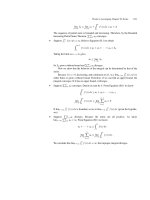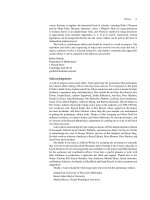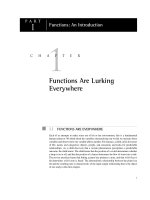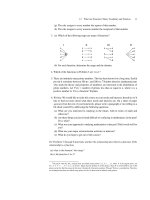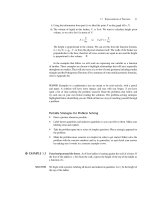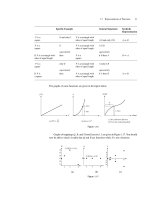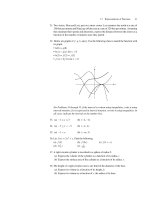Calculus: An Integrated Approach to Functions and their Rates of Change, Preliminary Edition Part 32 docx
Bạn đang xem bản rút gọn của tài liệu. Xem và tải ngay bản đầy đủ của tài liệu tại đây (260.78 KB, 10 trang )
8.3 Derivatives of Sums, Products, Quotients, and Power Functions 291
Suppose lim
x→a
f(x)=L
1
and lim
x→a
g(x) = L
2
, where L
1
and L
2
are finite. Then:
(1) lim
x→a
[f(x)±g(x)] = L
1
± L
2
The limit of a sum/difference is the
sum/difference of the limits.
(2) lim
x→a
[f(x)·g(x)] = L
1
· L
2
The limit of a product is the product of the
limits (in particular, g(x) may be constant:
lim
x→a
kf (x) = kL
1
).
We can use principles (1) and (2) given above to prove two properties of derivatives, the
Constant Multiple Rule and the Sum Rule, stated in Section 7.4 and worked with in the
Exploratory Problem for Chapter 7.
Properties of Derivatives
Constant Multiple Rule
d
dx
kf(x) = k
d
dx
f(x) or (kf )
(x) = kf
(x), where k is any constant.
Multiplying f by a constant k multiplies its derivative by k.
Sum Rule
d
dx
[f(x)+g(x)] =
d
dx
f(x)+
d
dx
g(x) or (f + g)
(x) = f
(x) + g
(x)
The derivative of a sum is the sum of the derivatives.
These properties are natural from a real-world point of view.
Sum Rule:. Suppose a juice manufacturer is packaging cranapple juice by pouring cran-
berry and apple juice simultaneously into juice containers.
Let c(t) be the number of liters of cranberry juice in a container at time t.
Let a(t) be the number of liters of apple juice in a container at time t.
Then c(t) + a(t) is the amount of juice in the container at time t.
It follows that
da
dt
and
dc
dt
are the rates at which apple and cranberry juice, respectively, are
entering the container.
d
dt
[a(t) + c(t)] is the rate at which juice is entering.
d
dt
[a(t) + c(t)] =
da
dt
+
dc
dt
Constant Multiple Rule:. An athlete and a Sunday jogger start at the same place and run
down a straight trail. Let s(t) be the position of the Sunday jogger at time t. If the position
of the athlete is always k times s(t), then her velocity is k times that of the jogger.
d
dt
ks(t) = k
ds
dt
292 CHAPTER 8 Fruits of Our Labor: Derivatives and Local Linearity Revisited
The Sum and Constant Multiple Rules are very important results and were the topic
of the exploratory problems for the previous chapter. Proofs are provided at the end of the
section. We will assume in the chapters that follow that you have completed the exercises
below asking you to prove these rules and make sense out of them.
EXERCISE 8.5 Using the limit definition of derivative prove the two statements made above.
EXERCISE 8.6 Argue that the two properties above make sense from a graphical perspective.
EXERCISE 8.7 Differentiate the following.
(a) y =
2 + 3x
3
+
√
5x
x
(b) y =
4
√
x
π
+
3
√
πx
7
Answers to these Exercises are provided at the end of the section.
The Product Rule: Differentiating f(x)·g(x)
From the simplicity of the Sum Rule and the Constant MultipleRule one might initiallyhope
that the derivative of a product is the product of the derivatives and similarly for quotients.
But this hope is quickly dashed by working through an example.
2
Suppose, for instance, f(x)=x and g(x) =x
2
. Then f
(x) = 1 and g
(x) = 2x,so
f
(x) · g
(x) = 1 · 2x = 2x. On the other hand, f(x)·g(x) =x ·x
2
= x
3
; we know that
(f (x) · g(x))
should be 3x
2
, not 2x.
CAVEAT The derivative of a product is not the product of the derivatives.
However, if we know the derivatives of f and g,wecan find the derivative of their product
in terms of f , g, f
, and g
.We’ll figure out how to do this by working through the following
example.
◆
EXAMPLE 8.4 A farmer growing a crop of tomatoes wants to know when he should harvest and sell them
in order to collect the most revenue. Both the weight of the crop and the price of tomatoes
are changing over time. Let W(t) be the weight (in pounds) of his crop of tomatoes t days
after the beginning of the harvest season, and let P(t) be the going price (in dollars per
pound) for tomatoes on day t. Then the revenue the farmer will receive for selling his crop
on day t will be given by (weight in pounds) · ($/lb):
R(t) = W(t)·P(t).
Suppose that W(t)and P(t)are both differentiable functions. As long as R
(t) > 0, waiting
to harvest the crop will increase revenue. We want to compute R
(t).
Let W , P , and R be the change in weight, price, and revenue over the time interval
t. There are two components contributing to the change in revenue:
W · P (the change in revenue due to increase in the weight of the tomatoes), and
W · P (the change in revenue due to increase in the price).
2
Leibniz himself wondered about this in an unpublished manuscript dated November 1675 and concluded that the rules were
not that simple. He arrived at the Product Rule ten days later. (Burton, p.372)
8.3 Derivatives of Sums, Products, Quotients, and Power Functions 293
We are interested in
dR
dt
, the rate at which revenue is changing with respect to time.
dR
dt
= lim
t→0
R
t
.
The broad brushstroke of our argument looks like this.
R = W · P + W · P Divide by t.
R
t
=
W
t
· P + W ·
P
t
Take the limit as t → 0.
lim
t→0
R
t
= lim
t→0
W
t
· P + lim
t→0
W ·
P
t
dR
dt
=
dW
dt
· P + W ·
dP
dt
We will fill in more of the details while looking at the geometry of the problem. For
simplicity’s sake, suppose that W and P are both increasing with time.
W = W(t + t) − W(t) and P = P(t +t) − P(t)
R = R(t + t) − R(t)
R = W(t + t)P(t + t) − W (t)P(t)
The drawings below will help us express R in terms of W and P .
Revenue is represented by the area of a rectangle the length of whose sides represent
the weight and price of tomatoes at a fixed time.
W(t + ∆t)
R(t + ∆t) = W(t + ∆t) P(t + ∆t)
R(t) = W(t) P(t)
P(t + ∆t)
W(t)
W(t)
∆W
∆W
∆W
∆W
∆ P
∆ P
∆ P
∆ P
}
}
}
}
}
P(t)
P(t)
(a)(b)
(c)
W(t)
P(t)
Figure 8.7
R = R(t + t) − R(t)
=
area of the entire
large rectangle
−
area of the
hatched rectangle
R can be represented by the three shaded rectangles shown in Figure 8.7(c).
294 CHAPTER 8 Fruits of Our Labor: Derivatives and Local Linearity Revisited
R = (W)P(t) + (P )W (t) + (W )(P )
R
t
=
(W )P (t)
t
+
(P )W (t)
t
+
(W )(P )
t
dR
dt
= lim
t→0
R
t
= lim
t→0
(W )P (t)
t
+
(P )W (t)
t
+
(W )(P )
t
= lim
t→0
(W )P (t)
t
+ lim
t→0
(P )W (t)
t
+ lim
t→0
(W )(P )
t
Note that P(t)and W(t)are unaffected by letting t approach zero, so we obtain
dR
dt
=P(t) lim
t→0
W
t
+ W(t) lim
t→0
P
t
+ lim
t→0
W
t
P .
By definition
lim
t→0
W
t
=
dW
dt
and lim
t→0
P
t
=
dP
dt
.
Therefore,
dR
dt
=P(t)
dW
dt
+W(t)
dP
dt
+
dW
dt
lim
t→0
P .
As t → 0, we know that P → 0,
3
so the last term is actually
dW
dt
·0. Thus,
dR
dt
=P(t)
dW
dt
+W(t)
dP
dt
.
Another way of writing this is
R
(t) = P(t)W
(t) + W(t)P
(t).
◆
We have constructed an argument that for increasing functions f and g,
f (x)g(x)
=f(x)g
(x) + g(x)f
(x).
This is known as the Product Rule. We will show below that this holds for the product of
any two differentiable functions f and g. Before doing this, let’s try an example.
◆
EXAMPLE 8.5 Find the derivative of each of the following functions using the Product Rule.
i. q(x) =x
3
=x ·x
2
ii. h(x) =
√
7x(x
2
+3x +2)
SOLUTION
i. q
(x) = x ·
d
dx
x
2
+x
2
·
d
dx
[x] =x ·2x +x
2
·1 =2x
2
+x
2
=3x
2
ii. h(x) =
√
7 ·
√
x(x
2
+3x +2),so
h
(x) =
√
7 ·
1
2
√
x
(x
2
+ 3x + 2) +
√
x(2x +3)
◆
3
We know that the change in price approaches 0 as t approaches 0, because P is continuous. P must be continuous, because
we have assumed it is differentiable.
8.3 Derivatives of Sums, Products, Quotients, and Power Functions 295
Proof of the Product Rule
Let j(x)= f(x)g(x), where f and g are differentiable functions.
f (x)g(x)
= j
(x) = lim
h→0
j(x +h) − j(x)
h
= lim
h→0
f(x +h)g(x + h) − f (x)g(x)
h
We’d love to see a f(x +h)
g(x + h) − g(x)
in the numerator, but we’re missing the
−f(x +h)g(x) term. However, −f(x+h)g(x) + f(x +h)g(x) = 0, so we can write
f (x)g(x)
= lim
h→0
f(x +h)g(x + h) − f(x +h)g(x) + f(x +h)g(x) − f (x)g(x)
h
= lim
h→0
f(x +h)g(x + h) − f(x +h)g(x)
h
+
f(x +h)g(x) − f (x)g(x)
h
= lim
h→0
f(x +h)
g(x + h) − g(x)
h
+ g(x)
f(x +h) − f(x)
h
= f(x)g
(x) + g(x)f
(x).
We’ve now proven the Product Rule.
The Product Rule:
f (x)g(x)
= f(x)g
(x) + g(x)f
(x)
EXERCISE 8.8 Show that computing the derivative of kf (x) is a special case of the Product Rule. In other
words, apply the Product Rule to kf (x) and show
d
dx
kf(x) = k
df
dx
.
The answer to this Exercise is provided at the end of the section.
The usefulness of the Product Rule will become increasingly apparent as the number
of types of functions we can differentiate increases. Now we will see how the Product Rule
enables us to differentiate a whole family of power functions in the blink of an eye, without
having to return to the limit definition of the derivative.
The Derivative of x
n
for n a Positive Integer
Mathematicians, like other scientists, look for patterns. Upon observing a pattern, a math-
ematician tries to generalize his observations and prove that the pattern holds true.
Let’s gather our results from applying the limit definition of derivative to power
functions, functions of the form x
n
for n a constant. When looking for patterns, one must
often play around with the form in which an expression is written. Results from Examples
and Exercises are gathered in the table on the following page and written in a form so that the
pattern is readily accessible. You can add results from other problems you have completed.
296 CHAPTER 8 Fruits of Our Labor: Derivatives and Local Linearity Revisited
f(x) f
(x)
x
3
3x
2
x
2
2x
x 1
x
1
2
1
2
x
−
1
2
x
−1
2
−1
2
x
−
3
2
x
−1
−x
−2
Looking at this table we might conjecture that the derivative of x
n
is nx
n−1
. Below we
prove this conjecture for n any positive integer. The method we will use is called mathe-
matical induction; it works on the domino principle. Suppose we arrange a collection of
dominos in a line so that if any one domino falls, we are sure that the domino next to it will
also fall. Then, if we knock over the first domino in the line, all the rest of the dominos will
also be knocked down.
Proof by mathematical induction works similarly except that the dominos are the
positive integers, so there are infinitely many of them.
i. First show that the statement
d
dx
x
n
= nx
n−1
holds for n = 1.
We show that the first domino will fall.
ii. Then we show that if
d
dx
x
k
= kx
k−1
is true for some arbitrary k, where k is a positive
integer, then it must also be true for k + 1. In other words, we must show that if
d
dx
x
k
= kx
k−1
, then
d
dx
x
k+1
= (k + 1)x
k
. This is called the inductive step.
We show that if any one domino falls, it will knock down the domino after it.
Once this is shown our proof is complete. We will have shown that
d
dx
x
n
= nx
n−1
holds
true for n = 1, and that it therefore must hold true for n = 2; it holds true for n = 2, and
therefore must hold true for n = 3, and so on, ad infinitum. It must hold true for all positive
integers.
For more work with proof by induction, refer to Appendix D: Proof by Induction.
Proof Our hypothesis:
d
dx
x
n
= nx
n−1
.
i. Our hypothesis holds for n = 1.
If f(x)=x, then f
(x) = 1 = 1 · x
0
.
ii. Let’s suppose that our hypothesis holds for n = k.
(This is known as the induction hypothesis.) We will show that it must then hold for
n = k + 1. In other words, we show that
d
dx
x
k+1
= (k + 1)x
k
assuming
d
dx
x
k
= kx
k−1
.
Let h(x) = x
k+1
= x · x
k
.
By the Product Rule we know that
h
(x) = 1 · x
k
+ x ·
d
dx
x
k
.
But
d
dx
x
k
= kx
k−1
by the induction hypothesis.
8.3 Derivatives of Sums, Products, Quotients, and Power Functions 297
Therefore,
h
(x) = x
k
+ x · kx
k−1
= x
k
+ kx
k
= (k + 1)x
k
.
Our proof is complete. The derivative of x
n
is nx
n−1
for n = 1, 2, 3, ,that is, for n any
positive integer.
EXERCISE 8.9 Differentiate f(x)=πx
19
− 5x
5
+
3x
6
2
+ 7(π)
3
.
Answer
f
(x) = 19πx
18
− 25x
4
+ 9x
5
. (Why is the derivative of 7(π)
3
zero and not 21(π)
2
?)
The Quotient Rule
Although it is tempting to try to differentiate
f(x)
g(x)
by dividing f
by g
, this is incorrect.
Below we use the Product Rule to arrive at a rule for differentiating a quotient.
4
Let h(x) =
f(x)
g(x)
, where f and g are differentiable functions. We are looking for h
(x).
f(x)=g(x) · h(x) Differentiate both sides of the equation.
f
(x) = g
(x) · h(x) + g(x) · h
(x) Solve for h
(x).
g(x) · h
(x) = f
(x) − g
(x) · h(x)
h
(x) =
f
(x) − g
(x) · h(x)
g(x)
But h(x) =
f(x)
g(x)
.
=
f
(x) − g
(x) ·
f(x)
g(x)
g(x)
=
f
(x) ·g(x)
g(x)
−
g
(x) ·f(x)
g(x)
g(x)
=
f
(x) · g(x) − g
(x) · f(x)
g(x)
·
1
g(x)
=
f
(x) · g(x) − g
(x) · f(x)
[g(x)]
2
f
g
(x) =
f
(x) · g(x) − g
(x) · f(x)
[g(x)]
2
This is the Quotient Rule for taking the derivative of the quotient of two functions.
d
dx
f(x)
g(x)
=
g(x) · f
(x) − f(x)·g
(x)
[g(x)]
2
or, without the x’s,
f
g
=
g · f
− f · g
g
2
4
This is the argument that Leibniz used in the 1670s after realizing that the derivative of a quotient is not the quotient of the
derivatives.
298 CHAPTER 8 Fruits of Our Labor: Derivatives and Local Linearity Revisited
Notice that the order in which you do the subtraction matters. Here’s a mnemonic to
remember which term in the numerator comes first; take it or leave it. “Don’t get fouled up”
translates to gf
(g for “get,” f for “fouled,” and
for “up”). Now that you have started,
you’re all set.
EXERCISE 8.10 Differentiate f(x)=
2x
7
+3
2x+1
.
Answer
f
(x) =
24x
7
+14x
6
−6
(2x+1)
2
Knowing the Quotient Rule allows us to differentiate x
n
, where n is a negative integer.
We’ll differentiate h(x) =
1
x
m
, where m is positive.
1
x
m
= x
−m
, so the exponent of x is
negative.
If the exponent algebra in this proof is hard for you to follow, skip to Section 9.2 or the
Algebra Appendix and, after studying that section, try this proof again.
h(x) =
1
x
m
h
(x) =
x
m
· 0 − mx
m−1
(x
m
)
2
=
−mx
m−1
x
2m
(because (x
a
)
b
= x
ab
)
=−mx
(m−1)−2m
(because
x
a
x
b
= x
a−b
)
=−mx
−m−1
This result fits our established pattern.
d
dx
x
−m
=−mx
−m−1
Therefore,
d
dx
x
n
= nx
n−1
for any integer n.
We’ve proven this result for n a positive integer using induction and for n a negative integer
using the Quotient Rule. Verify that the result is true for n = 0 on your own. In fact, this
result is true for any exponent, but we will not be able to prove this until we know more
about exponential functions, their inverse functions, and taking the derivative of composite
functions.
Answers to Selected Exercises
Answers to Exercise 8.5
i. If k is a constant, the derivative of kf (x) is kf
(x).
8.3 Derivatives of Sums, Products, Quotients, and Power Functions 299
Let g(x) = kf(x)
g
(x) = lim
h→0
g(x + h) − g(x)
h
= lim
h→0
kf (x + h) − kf (x)
h
= lim
h→0
k ·
f(x +h) − f(x)
h
= k · lim
h→0
f(x +h) − f(x)
h
(limit property (2))
= kf
(x)
ii.
d
dx
[f(x)+g(x)] =
d
dx
f(x)+
d
dx
g(x)
Let j(x)= f(x)+g(x)
j
(x) = lim
h→0
j(x +h) − j(x)
h
= lim
h→0
f(x +h) + g(x + h) − [f(x)+g(x)]
h
= lim
h→0
f(x +h) − f(x)
h
+
g(x + h) − g(x)
h
= lim
h→0
f(x +h) − f(x)
h
+ lim
h→0
g(x + h) − g(x)
h
(limit property (1))
= f
(x) + g
(x)
Partial Answers to Exercise 8.6
i. This makes graphical sense because multiplying f by k rescales the height of the graph
by a factor of k; therefore the ratio
rise
run
is rescaled by a factor of k as well. (See
Figure 8.8.)
ii. The height of the function f + g is the height of f plus the height of g. Therefore,
rise
run
=
rise due to f + rise due to g
run
=
f
x
+
g
x
.
x
y
2f
f
the slope of 2f is twice the slope of f.
Figure 8.8
300 CHAPTER 8 Fruits of Our Labor: Derivatives and Local Linearity Revisited
Answers to Exercise 8.7
(a) y =
2
x
+ 3x
2
+
√
5, so y
=−
2
x
2
+ 6x
(b) y =
4
π
·
√
x +
3
√
π
7
· x,soy
=
4
π
·
1
2
√
x
+
3
√
π
7
· 1 =
2
π
√
x
+
3
√
π
7
Answer to Exercise 8.8
Let y = kf (x).
Then y
= 0 ·f(x)+k·f
(x) = kf
(x).
PROBLEMS FOR SECTION 8.3
For Problems 1 through 8, find f
(x). Strategize to minimize your work. For example,
x
2
+3
3x
does not require the Quotient Rule.
x
2
+3
3x
=
x
3
+
1
x
=
1
3
x + x
−1
. This is simpler
to differentiate.
1. f(x)=3x
2
+3x +3+3x
−1
+3x
−2
2. f(x)=
x−2x
2
5
3. f(x)=π(3x
2
+7x +1)(x −2)
4. f(x)=
1
x
2
+4
5. f(x)=
x
x+2
6. f(x)=
x+2
x
7. f(x)=(
5x
2
2
+ 7x
5
− 5x)x
8. f(x)=
a
x
+ bx(c −dx), where a, b, c, and d are constants.
For Problems 9 through 11, rewrite each of these functions in a form that allows you to
differentiate using the tools you have now, but with as little exertion as possible. Then
differentiate. Work on strategy; none of these problems require the Quotient Rule.
9. (a) f(x)=
(x
2
+2x)x
3
(b) f(x)=
(x
2
+1)
2
x
10. (a) f(x)=
1
x
+1
x+1
x
2
+2x
(b) f(x)=
(x
3
+3x)
2x
4
11. (a) f(x)=(x + 1)(x − 1)x (b) f(x)=
x+
1
x
x
For each function in Problems 12 through 14:
(a) Sketch the graph of f .
(b) Find f
(x). Are there any values of x for which f
is undefined?
12. f(x)=x +|x|
